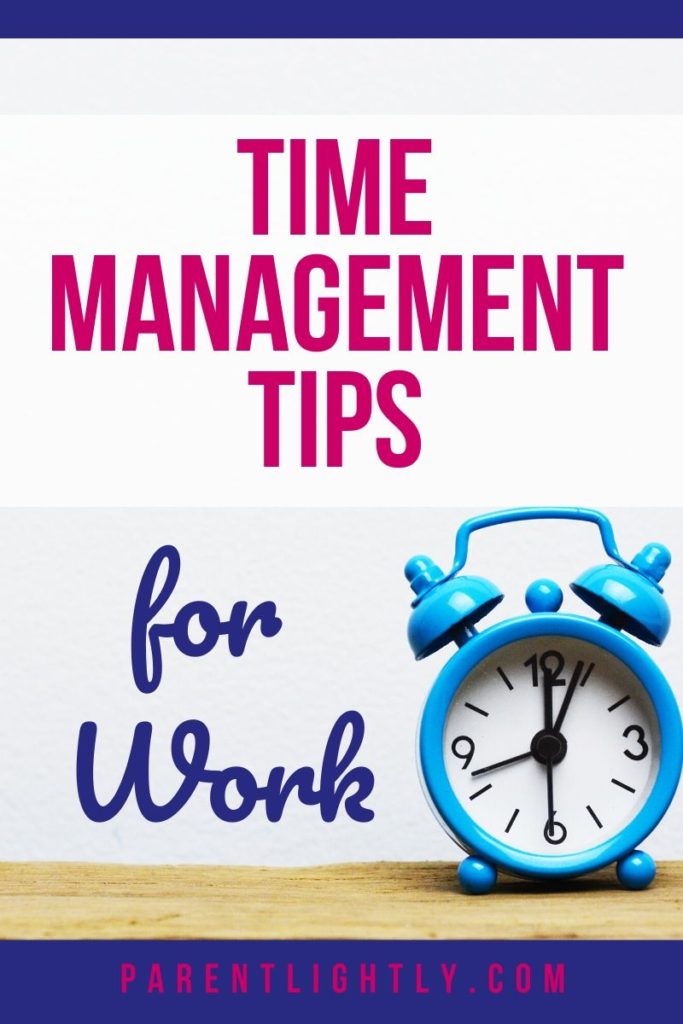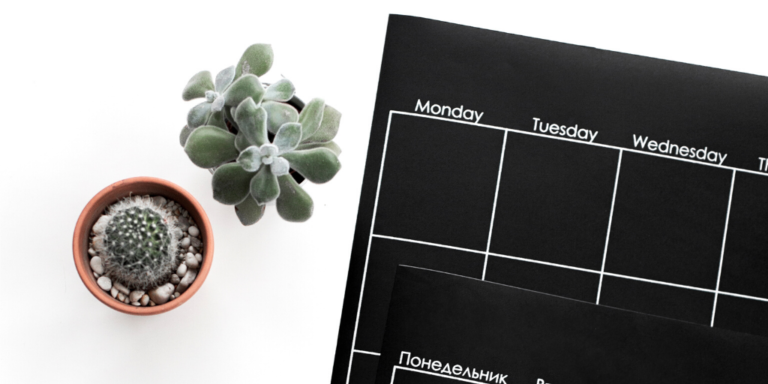5 Simple Steps to the most productive work schedule yet!
Does your workday feel frantic and fragmented? When 5 pm arrives, do you wonder what you did all day? You’re not alone.
According to a study conducted by University of California, Irvine Professor Gloria Mark, high tech workers switch tasks, on average, every three minutes and five seconds! In the study, about half of the interruptions were initiated by the worker, not someone else.
In other words, you’re distracted and it’s not just because your co-workers are pinging you every five seconds.
What’s the cost of all of that switching? In short, more stress. Workers in the study scored significantly higher on stress level, frustration and mental effort when they were interrupted. I don’t know about you, but I don’t need any extra stress or frustration at work. I need to save that mental energy for the important work – and parenting!
Trying to multitask also decreases your effectiveness. In the short term, multitasking increases the number of errors you make. In the long term, it can actually cause a decline in your brain function!
I don’t know about you, but I’m convinced that I need to quit checking email while I’m on a conference call. But how?

How to organize a productive work schedule in 5 steps
Switching tasks takes time and mental effort. It also makes us feel more stressed at work. To maximize your productivity, you probably need to overhaul your schedule. Most of us end up with work calendars cluttered by meetings, leaving no open space for us to do in-depth work, learning and planning. It’s time to change all that today.
Step 1: Eliminate Unnecessary meetings
If your calendar is anything like mine, you probably have a number of recurring meetings that you don’t really need. Look at your schedule over the course of the next month and ask yourself the following questions:
- Am I really needed in this meeting?
- Could this meeting be handled via email?
- Can this meeting be held less frequently?
- Could this meeting be shorter?
If you have input into the meeting’s schedule and attendee list, talk to the other participants. Many people will be thrilled and relieved to eliminate a recurring meeting or reduce its footprint on their calendars.
Of course, there are some meetings for which you can’t control the schedule. For those meetings, you can ask whether you need to attend every instance if you think that conversation is acceptable in your workplace. Tread lightly!
Step 2: Consolidate meetings (mornings/certain days)
Over time, my meeting schedule seems to take over all day every day. When I really look at my calendar I usually only have 3 or so hours of meetings. But when they’re spread throughout the day, it feels like I do nothing but go to meetings – even though that’s less than half of my day.
To save yourself from meeting jumping, see if you can consolidate your meetings into just part of the day or a few days a week. Don’t pack yourself back to back, because that’s a challenge, too. But if you can attend meetings only three days a week or only in the morning, you’ll free up big chunks of time for deep work.
If you decide to try to push meetings to certain days or times, block your schedule during your “deep work” times. Even if you can only block two afternoons a week, that is likely a significant improvement over your current calendar. Don’t be shy about declining meetings when people try to schedule over their work block. Rarely is a meeting so urgent that the person can’t wait until the next day or the afternoon. (If it is truly urgent and important, of course, you can make an exception.)
Step 3: Block days/times for broad themes depending on energy
Go a step further and think about blocking different days for different types of work. For example, I have a team of 8+ people and I have regular 1x1s with each person. Right now, these 30 minute 1×1 meetings are dispersed throughout my week. Instead, I could consolidate them to one day a week and dedicate other days to different work tasks.
Think about your energy levels throughout the day as you go about this exercise. Are you an introvert who is tired of peopling by 2 pm? Move your meetings to the morning. Are you more creative and motivated at the beginning of the week? Try to do your deep work and Monday/Tuesday and shift meetings to the latter half of the week.
Whatever your cadence is, think about the different types of work you do and when you have the most energy for each type of work. This will guide your choices about when to schedule meetings and work time.
Step 4: Eliminate/automate time wasting tasks
Sometimes we inherit regular tasks that are time-consuming but not obviously useful. If you have any recurring tasks like this, think critically about them. Ask the following questions about the tasks:
- Do these still need to be done?
- Can the cadence be less frequent?
- Is there a faster/better way to do this?
- Can we automate this?
Talk with your manager and colleagues about these questions, and then you can make a decision.
Step 5: Dedicate time to planning
Your day will be much more productive when you do some advance planning. I suggest devoting some time to this when your brain is otherwise cooked. The late afternoon on Friday is usually perfect for planning the upcoming week. Not only are you probably not doing anything productive with that time now, but you can also clear the decks mentally going into the weekend.
If Friday doesn’t work for you, pick another time when you’re low energy and look at the week ahead. Ask yourself these questions:
- Is there anything out of the ordinary in my schedule next week?
- What are my top priorities?
- Is there anything I can foresee that might disrupt my plan?
- Do I need to prepare any materials, equipment or information this week to help my future self?
- When will I work on my priorities?
- Can I cancel any meetings? Do I need to reschedule meetings?
I also recommend doing a quick daily planning session. I usually do this in the morning, over coffee, before walking my kids to the bus stop. Some people do a quick calendar once-over before they leave work in the evening. You can choose a time that works for you. The key is to make the planning happen! Block it on your calendar if you have to. 🙂

What are some hacks to discourage multitasking?
Even once you make over your calendar, you may still be tempted to multitask during your deep work blocks. To avoid switching tasks too frequently, use these tricks and tips. You will be so much more productive when you can stay on target. You’ll feel less stressed, too!
Pomodoro Technique
If you really need to crank something out, try the Pomodoro technique. It was developed by Francesco Cirillo, an expert in productivity, lean principles, and agile methodology. The concept of the Pomodoro technique is simple. Pick a task, and then follow this simple schedule for the time you have to work:
- Set a timer for 25 minutes. Do focused work on your task for that time.
- When the timer goes off, take a short break (around 5 minutes). Get some coffee, go to the bathroom, walk up and down the hall or do some squats at your desk.
- Repeat the pattern of 25 minutes of work plus a short break
- Once you have done four pomodoros (25 minute work chunks), take a longer break (20-30 minutes)
This method helps you focus while also giving yourself periodic breaks. It helps you make measurable progress in just one pomodoro.
By the way, the technique is called the pomodoro technique after a tomato kitchen timer! I use a timer on my web browser, but feel free to get your own vintage kitchen timer if you prefer.
Listen to music
I can focus much better when I listen to music. When I really have to finish some work and I’m struggling to stay on task, music keeps me from getting distracted by noise in my space. I’m also less likely to multitask for whatever reason.
Chrome Extension Website Blocker
That pesky Facebook really knows how to get our attention! If you leave it up on your web browser, it will be sending you notifications and messages constantly. It’s so hard to resist checking our notifications!
If you’re having trouble avoiding the time sink of social media and personal web browsing, you may have to take drastic measures. Install a Chrome extension like StayFocusd that will block certain websites (or everything!) during time periods you specify.
Take calls away from the computer
Some people spend a lot of time on conference calls, and it’s easy to check your emails while you’re on the phone. If you want to stop doing this, try to sit in a different location away from your computer while you’re on the phone. This could be in a different room or at the far end of your desk. You could even turn off your monitors during the call!
Get a stress ball
Sometimes we just need something to keep our fingers off the keyboard during conference calls! Get yourself a stress ball or simple puzzle. This will keep your hands busy – and away from the keyboard – when you’re on a call!
Meet in person if possible
If you can meet in person, do. Your focus will be much better in a physical meeting than on the phone. And you can’t be checking Instagram when you’re face to face with your co-worker.
FAQs about effective calendar management
Still have questions about the best way to manage your calendar? Don’t we all! Here’s everything you (still) want to know about time management at work.
Why is time management important in the workplace?
There are so many benefits to managing your time better at work!
- Your work product will be higher quality
- You’ll produce more work
- You can engage in more strategic efforts
- You’ll feel less stressed
- You’ll exert less mental energy on task switching
What are some good time management skills?
Learning some basic work time management strategies will serve you well in any situation. Here are some things you can work in if you struggle with time management at work:
- Practice saying no: If you don’t set boundaries for yourself, who will? And most people will respect your now.
- Find a way to focus: Whether that’s Pomodoro, Chrome website blocking extensions, music or something else, figure out what helps you focus.
- Prioritize: Learn to prioritize your work. We didn’t really get into that here, but you could set aside four hours a week for deep work only to fritter it away sorting your email inbox. Knowing what work is most valuable keep you from falling into that trap.
How do you reduce meetings in the workplace?
There are lots of ways to reduce meetings! Here are a few to consider:
- Propose a “no meetings” day for your company and stick with it.
- Decline meetings that you don’t need to attend or that don’t have a clear agenda. Until you understand the meeting purpose and your role in it, you can keep it off of your calendar.
- Ask yourself if this topic really needs a meeting. Can it be settled with a quick one to one phone call?
- Resist the notion that meetings make you important. We humans have a need to feel included. We don’t want meeting FOMO! But really, it’s OK. Most of these meetings are pretty boring and it’s OK for you to miss some.
- Have stand-up meetings. They can cut your meeting time by 25%!
How do you organize your work schedule?
However you decide to organize your most productive work schedule, you can only be productive if you put some thought into it. By adopting best practices for calendar management and learning work time management strategiesyou can reduce your meeting footprint and increase the time you have for focused, meaningful work. You’ll be more valuable to your company – and feel less stressed at the end of the work day. How great is that?!
I would love to work with you on a workday time makeover. If you have questions or need someone with a fresh eye, please email me (beth@ parentlightly.com)!





